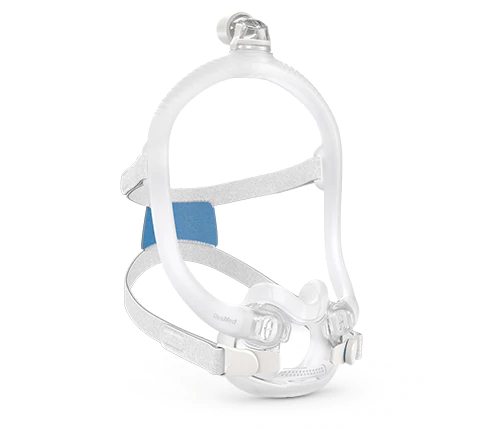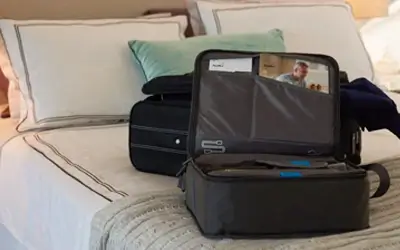The mask contains magnets that may interfere with certain implants or medical devices. Please refer to the Support documents for complete labeling information, including magnet contraindications and warnings.

ResMed AirFit F30i is a full face mask featuring a top-of-head tube connection designed to give users the freedom to sleep in many positions.
The secret behind this mask's comfortable, high-performing seal is its UltraCompact cushion design, which curves under the nose for a comfortable and secure fit. It also features a quick-release 360o elbow that makes it easy to connect and disconnect the tubing.
You now have an entire collection of ResMed full face mask options - from top-of-head tube connection and front-end tube connection to memory foam and silicone - each catered to individual user needs.
Regular inspection of your mask is essential to ensure it is working correctly. If any damage is found, the mask component should be replaced.
If air is escaping the mask cushion from any area other than the vent, try the following steps to locate and stop the leak.
For additional therapy assistance.
Documents
Here are some links to help your patients get on the right track with the sleep therapy..

Access extra service and support by registering your ResMed product.

For further support, our free myAir program offers ongoing care and guidance via personalised therapy tips, coaching and advice.

If you have any questions regarding warranty information on our masks, please contact our local customer service team.
From diagnostics and healthcare informatics to therapy devices and masks, our solution can help you get a better night's rest. Crafted to offer both confidence and flexibility, our products allow for a high-quality therapy experience catered to your needs.
Our device, mask and accessory ranges, together with our online support program myAir™, enable you to easily customise your therapy experience to your preferences.
* As of October, 2019. Based on available user guide data. The total weight of AirFit N30, which includes the headgear and excludes the packaging, is 45g.
ResMed guided external clinical study of 17 evaluable CPAP mask users from 12-25 February, 2019 in Sydney, AU who trialled ResMed AirFit N30 at home for 7 nights in place of their prescribed mask, ResMed AirFit P10. CPAP users rated subjective criteria for AirFit N30 and AirFit P10 on a Likert Scale of 0-10.
Statistically significant differences (p >0.05) in median scores were found between the two masks, AirFit N30 and AirFit P10.
The myAir™ for Air10™ by ResMed app is available for AirSenseTM 10 and AirCurve 10 devices with build-in wireless connectivity only. Wireless communication depends on network availability.